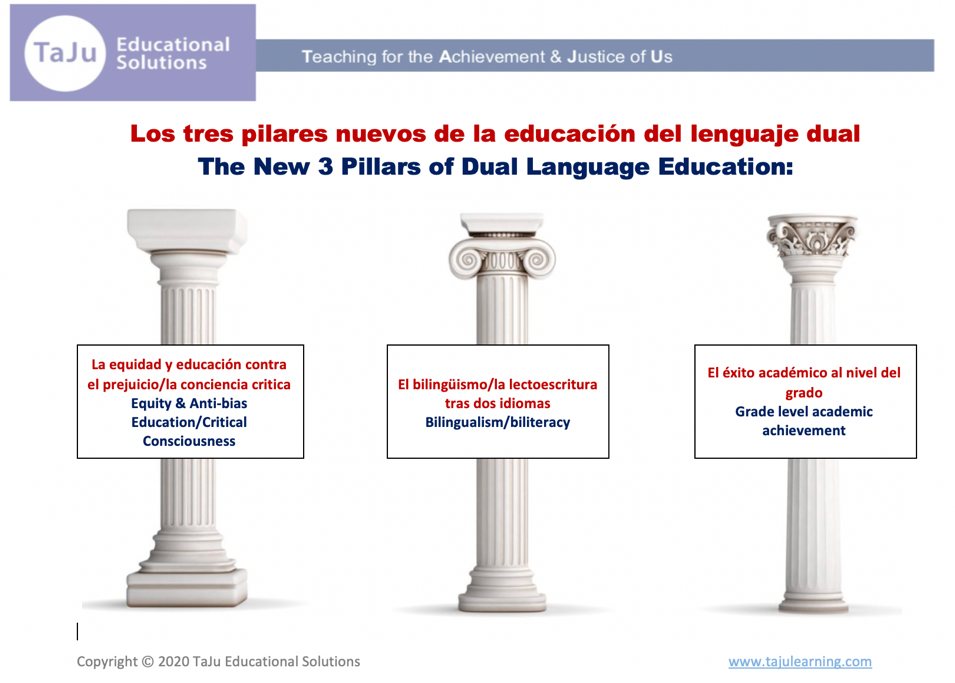
Dual-language programs, especially two-way programs, have exploded in the world of language programming. The allure of dual language’s three pillars was enough for many districts to try to sign up for them almost overnight. For a short time, we even sat together as a dual-language community with our voices united for the three pillars*, “biliteracy/bilingualism, grade-level academic achievement in two languages, and… whatever, that third one.” Yet it didn’t take long for many dual-language programs to experience a range of challenges to achieving the three-pillar promise, especially for the language learners they were designed for.
Having been involved in dual language in some way, shape, or form for most of my life, I can assure you that the struggle is not a reflection of a flaw in dual language. Rather, the root of many struggles has to do with this third pillar that always seems to be forgotten, misunderstood, and left for another time as enrichment. So, what’s the problem with Pillar III? Even among scholars and practitioners in dual language, the terms used for Pillar III are vague, inaccurate, and limited in ways that amplify inequities for some people. It is called anything from positive cross-cultural attitudes and high self-esteem (Lindholm, 1990), cross-cultural awareness (Genesee and Gándara, 1999), or biculturalism (Gort, 2008) to cross-cultural or multicultural competence (Christian, Howard, and Loeb, 2000; Lindholm-Leary, 2011) or positive cross-cultural attitudes and behaviors (Howard, Sugarman and Christian, 2003). These labels and definitions are innately flawed because these terms are essentially confined to the following:
1. Enrichment: To add greater value or abundance; to make better in quality;
2. Cross-cultural: The intersection between those characteristics, beliefs, norms, values, etc. that define an association with a group;
3. Awareness: Becoming informed and receptive to gaining knowledge;
4. Competence: Being adequate; having the required skill, qualification, or savvy/knowledge;
5. Attitude: The individual’s reaction, feeling, or mindset that frames their mood;
6. Self-esteem: Having respect for oneself.
So again, what’s the problem with that? Things like having a positive attitude, behaviors, and self-esteem are important—especially if we are to maintain respectful learning environments where every stakeholder can thrive. However, if schools perceive this pillar as enrichment, third, and focused on student feelings and learning about culture, it becomes very easy to ignore the reason that dual language came to be. Calling it enrichment and positioning Pillar III as last has communicated, “it’s okay to be different as long as it doesn’t disrupt my order,” on the really important things like curriculum and assessment, for example.
Such a mentality has taken us further away from the “why” of dual language that is rooted in the immigrant struggle, rooted in the injustice of schools that continue trying to remediate bilingualism, and rooted in a multigenerational fight for simple access to an educational experience that would ensure sufficient resources, evidence-based strategies, and monitoring systems specifically designed for the multilingual and emergent-bilingual student demographic.
These challenges are amplified in two-way models when you add in issues of privilege and power between the English and non-English students, families, co-teachers, and building administrators, not to mention district power dynamics. There are three key actions that must be taken right now to unravel these challenges and contradictions. First, it must be recognized that dual language is not enrichment but a lifeline toward educational access for students who have been hurt and handicapped by the approach of their education.
Therefore, we must replace the old three pillars with new pillars designed to grant and protect access to educational lifelines for immigrant, emergent-bilingual, and Black and Brown students—who still lack access to basic things like resources, evidence-based practices, environments, and accountability systems.
These new pillars are based on sound theory and evidence for what is effective for them. Second, dual-language schools, educators, and district leaders must understand that the new Pillar I is intended for adults and children—if adults can’t model through words and actions, children won’t either. When we work with schools with dual-language and emergent-bilingual programs, critical to their design phase is an intensive year of equity, antibias, and critical consciousness training and coaching for the entire educational community.
All stakeholders gain awareness, competence, and the critical shifts in mindset that are prerequisites for equity to be achieved. Even schools that already have dual-language programs can “course correct” right now. Failing to build this equity and social justice foundation will create future challenges in decisions that must be made.
Third, prioritize the time, attention, capacity-building efforts, tools, resources, systems, and policy shifts necessary for dual language to be effectively implemented, successful in its outcomes, and sustainable over time. I know what you are saying. “Alexandra, we don’t have enough resources right now to prioritize this.” However, in every decision, we have the choice of whether to allocate time, attention, tools, and limited resources in ways that further hurt the students who already lack full access to a quality education or in ways that benefit them. Remembering that equity does not require or even ask for equality is one of the most powerful shifts in the new Pillar I (equity and antibias education/critical consciousness).
*Editor’s note: The dual language pillars come from the Guiding Principles for Dual Language Education – Third Edition (2018), collaboratively produced by the Center for Applied Linguistics, Dual Language Education of New Mexico, and Santillana USA. The pillars introduced here have been adapted from the Guiding Principles, 3rd Edition.
Alexandra Guilamo is a dual-language expert, author, keynote speaker, and CEAO (chief equity and achievement officer) at TaJu Educational Solutions. Visit www.tajulearning.com or follow Alexandra @TajuLearning on Twitter, Facebook, and Instagram.








